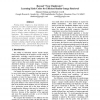Free Online Productivity Tools
i2Speak
i2Symbol
i2OCR
iTex2Img
iWeb2Print
iWeb2Shot
i2Type
iPdf2Split
iPdf2Merge
i2Bopomofo
i2Arabic
i2Style
i2Image
i2PDF
iLatex2Rtf
Sci2ools
ICPR
2010
IEEE
2010
IEEE
Beyond "Near Duplicates": Learning Hash Codes for Efficient Similar-Image Retrieval
Finding similar images in a large database is an important, but often computationally expensive, task. In this paper, we present a two-tier similar-image retrieval system with the efficiency characteristics found in simpler systems designed to recognize nearduplicates. We compare the efficiency of lookups based on random projections and learned hashes to 100-times-more-frequent exemplar sampling. Both approaches significantly improve on the results from exemplar sampling, despite having significantly lower computational costs. Learned-hash keys provide the best result, in terms of both recall and efficiency.
Computationally Expensive | Computer Vision | ICPR 2010 | Lower Computational Costs | Two-tier Similar-image Retrieval |
| Added | 04 Mar 2011 |
| Updated | 04 Mar 2011 |
| Type | Journal |
| Year | 2010 |
| Where | ICPR |
| Authors | Shumeet Baluja, Michele Covell |
Comments (0)

